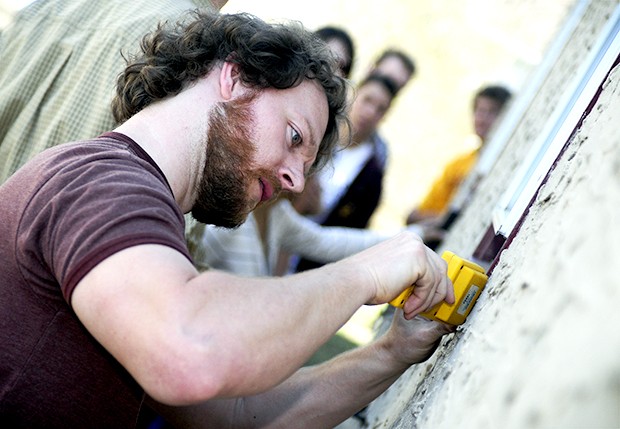University of Minnesota associate extension professor Pat Huelman and his building diagnostics and testing class surveyed the outside of a white stucco St. Paul home Wednesday afternoon, looking for signs of moisture damage. They were working alongside two University student groups, Engineers Without Borders and the Active Energy Club , that are doing an energy audit of the home with the goal of finding low-cost ways to improve efficiency. Inside, biosystems and bioproducts engineering sophomore Abby Morrisette sketched a floor plan of the small one and one-half story home. TheyâÄôll need that later, along with a window, appliance and light-fixture count, when they replace incandescent light bulbs and add insulation. In the living room, Chemical engineering and chemistry senior Andrew Jones removed several sensors. TheyâÄôd been there for the past week and a half, measuring things like the temperature, in and out of the house, and carbon dioxide. After the groups make improvements to the house, theyâÄôll make the same measurements to gage the houseâÄôs insulation. Beth Bowman and her 5-year-old son live in the home. She bought the house about a year ago, and applied to nonprofit Rebuilding Together Twin Cities for help finishing the attic and doing a home energy assessment. RTTC, which provides no-cost repairs for low-income home owners, matched the student groups with Bowman, who had requested some energy efficient repairs. Typically, volunteer groups are matched with others skilled in construction; itâÄôs unusual to get a group focused on energy auditing, program manager Marleen Stubee said. But energy efficiency is becoming more and more a part of their projects, she said, so theyâÄôre trying to connect with groups like the ones working on this project. These students and nonprofit Center for Energy and the Environment are also helping the RTTC with homeowner energy efficiency seminars. Since they canâÄôt purchase and use energy assessment sensors on their own, theyâÄôre hoping the studentsâÄô work will help them generate lists of simple repairs and changes homeowners can make on their own. Community outreach is part of the student groupsâÄô goal. Their work on this home is a pilot project, but they hope to find solutions and spread the word about sustainable ways many low-income families could improve their homes. At BowmanâÄôs home the students found the atticâÄôs only insulation consisted of old newspapers between the attic and first floor ceiling. Bowman would like to turn it into a living space, and on Wednesday Huelman discussed the challenges of the renovation. ItâÄôs not as simple as just slapping insulation on the walls and ceiling âÄî doing that can trap moisture in atticâÄôs wooden frame, risking mold and deterioration âÄî so itâÄôs important to understand things such as air flow in the house before making changes, he explained. Along with figuring out how to properly insulate the attic, the student groups aim to raise about $4,000 to make improvements to the house, including installing low-flow faucets and water-heater insulation. Their involvement has already prompted Bowman to consider changes she can make. Though she knew about weather stripping and energy efficient light bulbs, she said as a full time employee and parent, she hadnâÄôt taken the time out to scrutinize her house and make sure sheâÄôd done everything she could. âÄúThis is making me think about it,âÄù she said.

Image by Chris Roberts
Residential Building Sciences senior Jake McAlpine measures the relative humidity present in a St. Paul house’s surface Wednesday.
U students do home energy audit
U student groups teamed up with a University class to assess energy efficiency in a low-income home.
Published April 22, 2009
0
More to Discover







